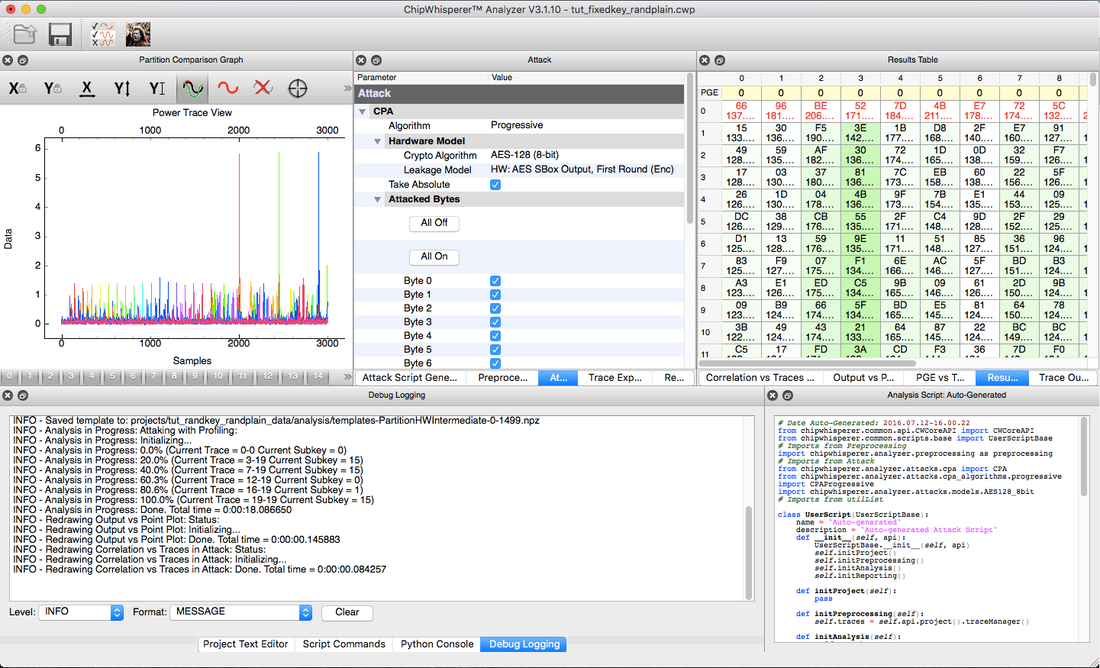CW-Analyzer Tool
The objective of this tool is to analyze the traces captured from a given scope.
Main features:
- CPA and Profiling attack;
- Built-in preprocessing modules (decimation, resync, digital filter, normalize and noise);
- Record preprocessed traces output;
- Execute custom analysis scripts;
- AES Key schedule calculator;
- Set of result widgets: Correlation vs Traces plot; Output vs Point plot; PGE vs Trace plot; PGE Table; Waveform Viewer.
Using the Analyzer
After loading the project, you will need to setup the analysis environment. In the analyzer, the settings tabs are used to automatically generate the analysis script (shown in the "Analysis Script" dock) that is executed when the attack is started. This way, the user can manually edit the code having even more flexibility. This code can also be saved and loaded both through the console (python filename) or the GUI. You can also copy this file to the analyzer/scripts folder so it will appear in the Project->Example Scripts menus in the next time you execute the tool.
In the "Analysis Script" dock, the constructor is called automatically every time a new script is generated. It is done because widgets like the waveform viewer should update the trace output of the preprocessing modules when the user modify its settings. The run() method is executed when the start analysis button is pressed. Custom methods can be executed by selecting it in the code and right clicking: a "Run Function" option will show up.
The "Attack Script Generator" is the main settings tab. It allows the user to set the Preprocessing modules that should be applied over the original traces and the Attack module. The Preprocessing and the Attack tabs will update accordingly.
The "Trace Explorer" tab enables a set of helper scripts needed by some of the analysis algorithms (like the POI detection in the Template attack).
Preprocessing Modules
Are filters that modify the traces from a given trace source (that can be another Preprocessing Module or the Trace Manager) and works as a new trace source to the next module in the chain (called trace observer).
Add Noise: Amplitude
Add random noise to the traces. Used for testing, has no use in actual analysis.
Add Noise: Time Jitter
Add random jitter. Used for testing, has no use in actual analysis.
Decimation: Clock Recovery
Attempts to 'recover' the clock by band-pass filtering, and then uses that to decimate to only points of interest. ****CURRENTLY NOT SUPPORTED****
Decimation: Fixed
Decimate (reduce the sample rate) by a fixed factor.
Digital Filter
Frequency specific filter.
Normalize
Normalize by standard deviation.
Resync: Cross Correlation
Use cross-correlation to detect shift between a 'reference trace' and every input trace. In practice the other resync methods seem to work better.
Resync: Peak Detect
Line up traces so peak (either max positive or max negative) within some given range of points all aligns.
For each trace the following must hold or the trace is rejected:
- (1-valid limit) < (peak value from candidate trace) / (peak value from reference) < (1+valid limit)
- If 'valid limit' is 0 then this is ignored, and all traces are kept.
Resync: Resample based on Zero-Crossing
Deal with resampling 'bins' based on zero-crossing detection.
Sum of Difference
Minimize the 'Sum of Absolute Difference' (SAD), also known as 'Sum of Absolute Error'. Uses a portion of one of the traces as the 'reference'. This reference is then slid over the 'input window' for each trace, and the amount of shift resulting in the minimum SAD criteria is selected as the shift amount for that trace.
See Sum of Absolute Difference (SAD) Pre-Processing for more information.
